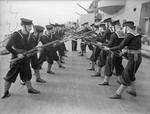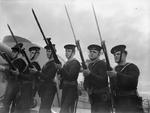Lee-Enfield No. 4 Rifle
| Country of Origin | United Kingdom |
| Type | Rifle |
| Caliber | 7.700 mm |
| Capacity | 10 rounds |
| Length | 1.130 m |
| Barrel Length | 635.000 mm |
| Weight | 4.100 kg |
| Rate of Fire | 20 rounds/min |
| Range | 503.000 m |
| Muzzle Velocity | 744 m/s |
Contributor: C. Peter Chen
ww2dbaseBritish weapons designer James Paris Lee drew the blueprint of the Lee-Enfield rifles from his earlier Lee-Metford design dated 1888. The Lee-Enfield bolt-action rifles were introduced to the British Army in Nov 1895, with soldiers immediately impressed by the rifles' high firing rate that reached 20 to 30 rounds per minute. Between 1895 and the 1930s, the design underwent several revisions, including efforts in the 1920s to make them cheaper and faster to manufacture.During WW1, American firms Remington Arms Company and Winchester Repeating Arms Company built a variant of the Lee-Enfield No. 4 rifle in the United States to arm the US Army for WW1. They were chambered for US ammunition and were slightly longer and slightly heavier. They were designated as M1917 in the US Army, and were commonly nicknamed as "Enfield"; the British called this variant design "Pattern 17".
By the late 1930s, the need for better Lee-Enfield rifles arose once again. In 1939, Lee-Enfield No. 4 Mk I rifles were issued, featuring lighter weight and cheaper to produce than previous variants. They were able to receive two types of bayonets, spiked and bladed. In 1942, Lee-Enfield Mk I* rifles with a slightly simplified design began to be manufactured by the Long Branch Arsenal in Canada and Savage-Stevens Firearms in the United States.
After WW2, Lee-Enfield No. 4 rifles continued to be improved and manufactured. Lee-Enfield No. 4 Mk 2 design went into production in 1946 and saw extensive use with the Irish Army, for example. The last significant action these rifles saw was the Korean War, where they were used extensively by Australian troops alongside of other Lee-Enfield variants. Lee-Enfield rifles of all variants continued to be the standard British and Commonwealth bolt-action rifles until 1957, and many of them remain in service today. 17 million Lee-Enfield rifles of all variants were made between 1895 and 1957.
Sources:
Ian Hogg, The Encyclopedia of Infantry Weapons of World War II
Wikipedia ww2dbase
Last Major Revision: May 2008
Lee-Enfield No. 4 Rifle Interactive Map
Photographs
 |  |
Lee-Enfield No. 4 Timeline
| 30 Jun 1941 | Small Arms, Ltd. of Mississauga, Ontario, Canada delivered its first products, five Lee-Enfield No. 4 rifles, for trials. |
Please consider supporting us on Patreon. Even $1 per month will go a long way! Thank you. Please help us spread the word: Stay updated with WW2DB: |
Visitor Submitted Comments
2. Anonymous says:
20 Jan 2016 01:41:01 AM
Serious error in this article. Please contact me by e-mail for information as to improvement.
20 Jan 2016 01:41:01 AM
Serious error in this article. Please contact me by e-mail for information as to improvement.
3.  Alan Chanter says:
Alan Chanter says:
1 Oct 2018 03:46:30 AM
The Lee-Enfield No.4 rifle was turned out in large numbers from new ordnance factories at Maltby and Fazakerly starting in late 1941, and from a new BSA factory at Shirley. In 1942 production reached 600,000 per annum. Wartime domestic rifle production, however, amounted to only around 2 million units, much less than the size of the British Army and much less than the requirements of Britain, the Empire and other nationalities. Supplies from overseas were therefore essential. From the end of 1941 the Long Branch arsenal near Toronto in Canada would make nearly one million, and the Savage arms company in Massachusetts in the USA over a million rifles. All these were interchangeable with British No.4s.
Meanwhile the earlier No.1 rifle continued to be made at BSA’s Small Heath plant until 1943, and at the long-established Lithgow Arms Factory in Australia (just over 400,000 rifles), while the long-established Ishapore rifle factory outside Calcutta built and repaired nearly 700,000.
1 Oct 2018 03:46:30 AM
The Lee-Enfield No.4 rifle was turned out in large numbers from new ordnance factories at Maltby and Fazakerly starting in late 1941, and from a new BSA factory at Shirley. In 1942 production reached 600,000 per annum. Wartime domestic rifle production, however, amounted to only around 2 million units, much less than the size of the British Army and much less than the requirements of Britain, the Empire and other nationalities. Supplies from overseas were therefore essential. From the end of 1941 the Long Branch arsenal near Toronto in Canada would make nearly one million, and the Savage arms company in Massachusetts in the USA over a million rifles. All these were interchangeable with British No.4s.
Meanwhile the earlier No.1 rifle continued to be made at BSA’s Small Heath plant until 1943, and at the long-established Lithgow Arms Factory in Australia (just over 400,000 rifles), while the long-established Ishapore rifle factory outside Calcutta built and repaired nearly 700,000.
4. The Sunrise Kid says:
30 Mar 2019 12:18:58 PM
Thank you very much, Alan Chanter!
30 Mar 2019 12:18:58 PM
Thank you very much, Alan Chanter!
5. War_Moose says:
15 May 2022 03:51:47 PM
I jave a No 4 MK J... anyone help me with this please!!!! I can find zero info on the MK J. It is a full barrel 1942 rifle
15 May 2022 03:51:47 PM
I jave a No 4 MK J... anyone help me with this please!!!! I can find zero info on the MK J. It is a full barrel 1942 rifle
6. Mark Mclerran says:
11 Jul 2022 11:37:10 AM
I have a rifle all it has on the rifle is no4 mk1 what do I have and what caliber is it
11 Jul 2022 11:37:10 AM
I have a rifle all it has on the rifle is no4 mk1 what do I have and what caliber is it
7. A.wilson says:
18 Aug 2022 10:39:10 AM
6. Mark, your rifle is as marked. A No.4 MK1. First produced in 1939, but not widely issued until 1941. Calibre .303'' same as other MKs. Some were converted to standard N.A.T.O. gauge of 7.62 mm in 1970 for sniper usage.
18 Aug 2022 10:39:10 AM
6. Mark, your rifle is as marked. A No.4 MK1. First produced in 1939, but not widely issued until 1941. Calibre .303'' same as other MKs. Some were converted to standard N.A.T.O. gauge of 7.62 mm in 1970 for sniper usage.
8. A.wilson says:
18 Aug 2022 10:43:46 AM
Also, users were trained to fire at least 15 aimed rounds a minute.
18 Aug 2022 10:43:46 AM
Also, users were trained to fire at least 15 aimed rounds a minute.
9. Donal says:
24 Dec 2022 05:29:55 AM
I have a longbranch sniper serial number 74L0168and am looking at a longbranch experamental in 222 serial no 0L7240, is this legit, fitted with 22" barrel and weaver mounts and scope
24 Dec 2022 05:29:55 AM
I have a longbranch sniper serial number 74L0168and am looking at a longbranch experamental in 222 serial no 0L7240, is this legit, fitted with 22" barrel and weaver mounts and scope
10. Alex Holder says:
7 Apr 2023 03:59:23 PM
Hello I have a Mk 2 no. 4 (F) 3|50 PF 88305 i would like no know the value and if it was in ww1 or 2 by chance?
Thank you
7 Apr 2023 03:59:23 PM
Hello I have a Mk 2 no. 4 (F) 3|50 PF 88305 i would like no know the value and if it was in ww1 or 2 by chance?
Thank you
All visitor submitted comments are opinions of those making the submissions and do not reflect views of WW2DB.
Change View
Desktop ViewSearch WW2DB

News
- » Wreck of Teruzuki Found (27 Jul 2025)
- » USS Orlean's Bow Found (22 Jul 2025)
- » The Emperor of Japan Planned to Honor WW2-era Japanese POWs in Mongolia (4 Jul 2025)
- » US State Lawmaker John Winter Caught Using Racial Slur "Jap" and Apologized (11 Jun 2025)
- » US Government Plans to Purge WW2 Information (17 Mar 2025)
- » See all news
Current Site Statistics
- » 1,181 biographies
- » 337 events
- » 45,132 timeline entries
- » 1,249 ships
- » 350 aircraft models
- » 207 vehicle models
- » 376 weapon models
- » 123 historical documents
- » 261 facilities
- » 470 book reviews
- » 28,426 photos
- » 365 maps
Famous WW2 Quote
"The raising of that flag on Suribachi means a Marine Corps for the next 500 years."James Forrestal, Secretary of the Navy, 23 Feb 1945
17 Oct 2014 01:44:22 PM
I LOVE THIS GUN